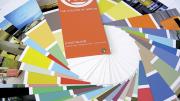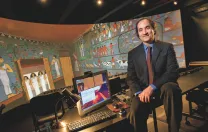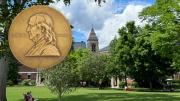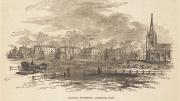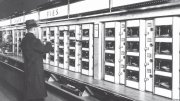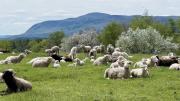Jesse Shapins helped create Zeega, a software program conceived to create database documentaries, but he is not a programmer. The lecturer in architecture might better be called an interpretive artist of urban space.
One of his first projects, Colors of Berlin, paired a Pantone color swatch (used to specify colors in print publishing) with a photograph of a place in Berlin where that color appeared. “The idea was to draw attention to things that we normally don’t pay attention to” in urban environments, he says: a garden hose, a trash can, a cat in a window. He envisioned that simple idea finding expression in multiple media: a print artifact (a book), a “modest” website, and an exhibition “that would bring [the idea] to life in space and allow audiences to come experience it” together. “I began to think about how to design a structure for the project that would allow it to take shape in different ways specific to those media,” drawing from an underlying database—a little ocean of expression that can rise up and coalesce into different forms.
“Designing a database is not just a technical project,” in his view. “At the beginning, it is a set of rules, and setting those rules is itself a creative research process. Then all these different manifestations can follow.”
In fact, none of the creators of Zeega—neither journalist Kara Oehler (a 2011-12 Radcliffe-Film Study Center Fellow), nor then economics graduate student James Burns, Ph.D. ’11—had been trained in writing code when they undertook a joint project called Mapping Main Street. The project is a self-sustaining online documentary narrative of what “Main Street” means in the United States, as seen through its creators’ eyes and those of citizen-participants. The result is surprising—in one town near the Mexican border, there’s a Main Street that serves as a major point of entry into this country; a Main Street elsewhere is the domain of streetwalkers—a sharp counterpoint to the imagined landscape of white picket fences frequently invoked by politicians and the media. (Pilot funding for Mapping Main Street came from an experimental initiative of the Corporation for Public Broadcasting, the Association of Independents in Radio, and the support of Harvard’s Berkman Center for Internet & Society; the project also appeared as a program of the same name on National Public Radio in 2009.)
Every week, people from all over the country still contribute to Mapping Main Street, Shapins reports. “The website operates on its own. In fact, it becomes a generative platform,” a framework that can accommodate all this public participation “because you have defined the boundaries and built a narrative structure.”
Mapping Main Street led to the idea of developing a set of tools that anybody could use to create such a project. “That’s where Zeega came from,” Shapins says. He, Oehler, and Burns are now working with French philosopher of science Bruno Latour to turn a notebook of his thoughts on philosophy, collected over a lifetime, into a database.
“I think it is really important for us to take agency in relation to technology,” says Shapins, who teaches a class on “Media Archaeology of Place” (to see a sample student multimedia project, “Revere Double Exposure,” visit www.harvardmagazine.com). Students understand that best when they realize that “somebody like themselves is writing the code that is setting terms for a project. And those terms…could be different.”

